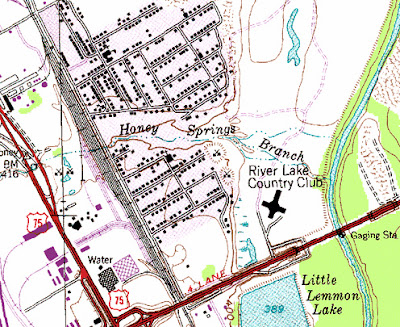Honey Springs on the Trinity River — Off The Beaten Path
 |
| Honey Springs Branch, Historic Joppa Freedman’s Community, Dallas, Texas |
The big rambling farmhouses that once commanded the views of this place were the focal points of now long gone pioneer family homesteads. Far ranging in scope and size, the Miller and Overton farms dominated this part of Texas for the latter half of the 19th Century. Reliable water was always a draw for early Texas settlers and the creeks and springs that dominate much of Oak Cliff and South Dallas served as a focal point.
Honey Springs was one such place, a complex story of water that is an interwoven yarn with the history of Texas itself. An underdeveloped ethos runs through this place that has allowed for small pockets of the once heralded Honey Springs to remain in a natural state.
 |
| Green Heron at the mouth of Honey Springs Branch and Wetland Cell G in the Chain of Wetlands, Great Trinity Forest |
The lure of finding the actual springs themselves started with the mouth of Honey Springs Branch where it enters Wetland Cell G at the Chain of Wetlands, just north of Loop 12 in an area called the Great Trinity Forest.
Be forewarned that the point blank, hard playing, hard living lives of the people here never vanished. The rough and tumble range fights with Texas Rangers and Indians over this very land might be trumped by the contemporary violence that is still seen today.
Honey Springs
The foggy and complex human history of this place tends to cloud what is one of the best looking little creeks in Dallas. The hickory, walnut and pecan grow tall in here beyond the backbrush of the formal riverbottom.
The confusion of where the historic flow of the spring was once sourced stumped the best of them.
 Author Gunnar Brune wrote an encyclopedic account of natural springs and seeps in Texas based first on work done in the 1970s and later published in a stand alone guide that commands a king’s ransom on Amazon. The couple thousand dollars for your own copy might be worth the expense if one were interested in tracking down some of the more obscure springs of the Lone Star State.
Author Gunnar Brune wrote an encyclopedic account of natural springs and seeps in Texas based first on work done in the 1970s and later published in a stand alone guide that commands a king’s ransom on Amazon. The couple thousand dollars for your own copy might be worth the expense if one were interested in tracking down some of the more obscure springs of the Lone Star State.
The book misses the mark when it comes to Honey Springs. It lists the source of Honey Springs as a spot near the Lisbon Cemetery in the former pioneer settlement that goes by the same name near Mentor and Gracey streets, a stone’s throw from the VA Hospital.
Fair enough. It’s a hard place to find. The deep history of this place goes back many generations but no one ever saw fit to put pen-to-paper writing it for posterity. Much of the happenings here were taken to the graves of the witnesses to it. The seemingly mundane hauling, plowing, fixing and mending of things left the place a century ago and now most likely will never have another voice to tell what went on here.
The real location of Honey Springs cuts through the community of Joppa (pronounced Joppie by locals) who claim the left bank of the Trinity as their own. The tinge of old campfire smoke still permeates this place. With the onset of autumn many residents use wood to heat food and stay warm.
 |
| A vacant lot in the Freedman’s Community of Joppa under a half moon lit time exposure at night. November 2013 |
A tough nut to crack if you want to befriend folks in Joppa. Joppa’s cornerstones remain as they were founded. Self-sufficency, and fidelity to family and community. They are slower to warm to a stranger than a cold pot of beans on coals. Once they get some trust in you, they are your best friends. Their proclivities get them slant wise with code inspectors or the local SPCA chapter from time to time, often when the rains don’t come and the price of hay skyrockets. I most likely came to know many when the drought of 2011 hit the small family ranchettes here and the inability to source hay.
 |
| Springs of Texas notation on the Battle Axe found at Honey Springs |
The name Honey Springs was first uttered most likely in some long forgotten Caddoan language of the Native Americans. Like many springs in Dallas County, the surrounding land was used for centuries by Native Americans dating back thousands of years. Honey Springs and a couple smaller creeks had many thousands of Native American artifacts recovered from their banks in the 19th century, evidence of a long lived population in this area. Those cultural splendors were lost to gravel mining in what were suredly vast into the reaches of history and time.
The oldest historic artifact that can be linked to Europeans in this area was a metal battle axe consistent with Spanish exploration in Texas. The provenance of the axe was never linked to any expedition. The notation of the find is listed in Gunnar Brune’s book as seen above in the passage.
The De Soto expedition was the first group of Europeans to explore this part of Texas in the 16th century. Led by Luis de Moscoso de Alvarado, the Native Americans the Spanish encountered here in North Texas spoke Caddoan and were called Canohatino by the French trappers pushing north along the Red River in the 17th century. It is believed this group eventually absorbed into the greater Confederacy of Caddo speaking groups (Yojuane, Kichai, Tawakoni, Taovayas, Iscani and Wichita). This Caddo group is what lived in North Texas through the late 18th century.
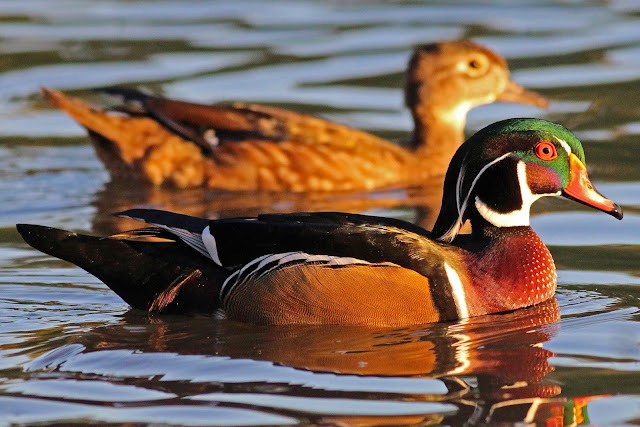 |
| Wood Ducks in Honey Springs Branch |
 |
| Mallards |
From the late 18th Century onward, North Texas was invaded by the Apache and Comanche. By 1660 both tribes had horses and expanded their range into North Texas. The Comanche were a Shoshonean group originally residing along the Upper Yellowstone and Platte Rivers. Beginning in the early 18th century they began a southern migration into the Great Plains. Here they drove a wedge between the Apache in the west and the Wichita to the east. By the early 1800’s the Comanche Nation stretched as far south as Austin, west to Raton Pass and east to Texarkana. Feared but few in number any Comanche history here was written in the blink of an eye. The real history is that of the Caddoan people who lived along the creeks here for many generations.
The Native Americans to this area were always quick to show visitors the spring here in what is now South Dallas, a place known for good reliable water and large numbers of hollowed out trees with honey bearing beehives.
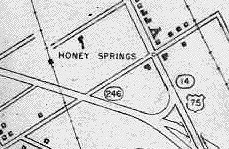 |
| Honey Springs on a circa 1920 map |
Honey Springs is near the junction of the Missouri, Kansas, and Texas railroad tracks and Honey Springs Branch, about five miles south of Dallas. Dugald McFarland was the original grantee of the land grant. The first settlers to remain in the area arrived with William Perry Overton from Virginia in 1844. Indians pointed out the two springs and abundance of wild honey in the area, and the settlers named their community Honey Springs. No organized township existed at the site until 1886, when the Missouri, Kansas and Texas Railroad came through Honey Springs. A section house was built there, which became known as Honey Springs Station. Honey Springs received mail from Lisbon, three miles west. Outgoing mail was hung on a pole for the conductor to grab as the train went by, and the incoming mail pouch was thrown from the train. Honey Springs had a population of fifteen in 1910. In 1937 Honey Springs voted to incorporate in order to avoid annexation by Dallas. In February 1946 the town voted to dissolve its corporation, and on December 18, 1946, Honey Springs was annexed to Dallas.
Bees are still attracted to Honey Springs Branch. Here at the mouth of where Honey Springs Branch flows into Wetland Cell G, the Corps of Engineers has planted American Lotus also known as Water Chinquapin.
American Lotus was a mainstay of Indians in the Americas and it is basically found east and south of the Rockies plus California. While the root, shoots, flowers and young seeds are edible, it was the root the Indians counted on to get them through the winter. The popularity of the Nelumbo lutea no doubt has also led to its many common names: Yellow Water Lotus, Yellow Lotus, Alligator Buttons, Duck Acorns, Water Chinquapin, Yonkapin, Yockernut and Pondnut. Many of them refers to the plant’s round, dark brown, half-inch seeds. Even its name is about the seed. Nelumbo is Ceylonese and means “sacred bean.” Lutea is Latin for yellow.
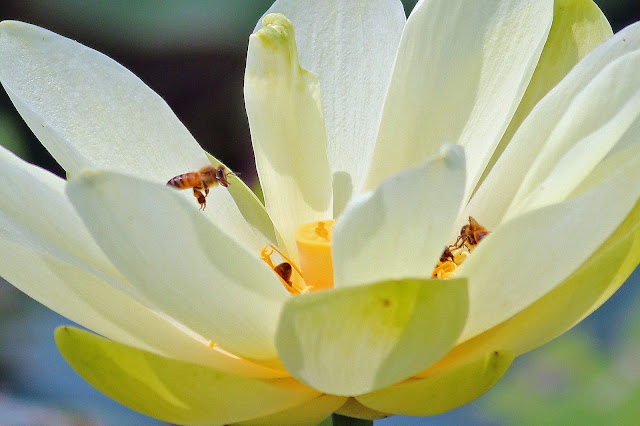 |
| Bees at the mouth of Honey Springs gathering the pollen from an American Lotus |
The Water Chinquapin is not a day lily, it is a two-day flower, the blossoms open one day, close for one night, open the second day then the petals drop off. The center of the flower grows and gets about three-inches big. It develops a seed pod with around 20 seeds and looks like a shower head.
 |
| Acorn size seeds inside the seed pods of a Water Chinquapin at the mouth of Honey Springs |
The deep water of the Chain of Wetlands, keeps nearly all wading birds from feeding in the cells themselves. Forced to the margins one of the only places they can stalk prey is the shallow mouth of Honey Springs Branch and Cell G. Here at the mouth with a prominent beaver lodge, birds like the Green Heron can fish with relative ease.
 |
| Green Heron perched on a beaver lodge at the mouth of Honey Springs Branch |
The Green Heron is sometimes called the Green-Backed heron. It is a smallish heron that is about the size of a large crow. It is a foot and a half to two feet in length. The green heron has a dark head with a small black crest. Its back and wings are dark gray-green to dark gray-blue. Its neck is rust colored. It has a dark bill and its legs are orange or yellow.
 |
| Green Heron |
Although secretive and skulking while creeping slowly through its wetland habitat, the Green Heron (Butorides virescens) is actually one of North America’s most recognizable wetland birds. Difficult to approach, these Green Heron photos were taken early in the evening approaching with the sun in the eyes of the bird and utilizing the streambed of Honey Springs as concealment. Crawling on hands and knees through the muck helped get low for the depth of field afforded by the unique stand of lotus in this spot.
 |
| American Wigeon male |
The natural course of Honey Springs originally entered the Trinity south of Loop 12. Over the decades with agricultural development, a golf course and then Loop 12’s embankment, Honey Springs was forced into some strange alignments before finding where it enters the wetlands today.
 |
| Members of the Trinity River Rod and Gun Club with Dallas Police Department at Little Lemmon Lake during the filming of the movie Bonnie and Clyde |
That constant water supply was a vital component to the success of the Trinity River Rod and Gun Club and their waterbodies, Little Lemmon and Lemmon Lakes that stretched from present day Loop 12 down to Simpson Stuart Road. Above is a photo of Dallas Police officers both uniformed and in costume along with Trinity River Rod and Gun Club members at Little Lemmon Lake during the filming of the movie Bonnie and Clyde. Photo is looking north with Little Lemmon Lake just beyond the trees.
 |
| Wood Ducks in Honey Springs |
Overtons and Millers
 |
| William Brown Miller |
The meandering creek bed takes twists and turns here up through the ash and oak to Joppa. It’s a spot of tangled wilderness that unties shoelaces and trip hazards underfoot as one heads up the rise. During the summer months the buntings and dicksissels sing at the edge of the taller trees here. In the winter, the bare trees are primed hunting roosts of hawks and kestrels. Setting off through the high grass and occasional Ironweed will take you into the deep wooded thickets and onto land once owned by the Overton and Miller Families.
North Carolina native William Overton came to settle this land in 1844 and was one of the first pioneers to settle the west bank of the Trinity River. Originally, he was granted the land along Turtle Creek in the area around present day Uptown. He left Texas for a time during the ’49 California gold rush and upon return to Dallas swapped a family member his Turtle Creek land for that around Honey Springs.
Willam Brown Miller was one of the original pioneers to settle this part of Dallas County. Born in Madison County Kentucky in 1807 Miller was the second of seven children born to John and Mary (Brown) Miller, native of Kentucky. In 1834 he began a dry goods business in Alabama. It failed in 1836, he moved to Tennessee to farm for ten years. In 1847 he moved to Dallas County, purchasing 562 acres and building a home on the Van Cleave Survey.
 |
| American Wigeon male |
At the conclusion of the Civil War, Dallas still lacked a railroad or a navigable river for commerce. With very few formal bridges of any kind over the Trinity, ferry crossings were important to the lifeblood of Dallas. Everything had to be hauled overland by oxen pulled wagons or horse teams. An early goal of the Dallas business community was to gain water transport along the Trinity River.
 |
| 19th Century ferry crossing on the Trinity River |
The problems associated with this effort included fluctuations of the river and the many snags that infested the channel. The first effort in this respect came in 1866, when the legislature chartered the Trinity Slack Water Navigation Company to provide improvements required for navigation from Galveston to Dallas. The company never started work on the project. That same year Miller formally chartered his own overland ferry enterprise on the Trinity River, the Honey Springs Navigation Company and the Honey Springs Ferry Company.
 |
| American Wigeon female |
 |
| Incorporation document for Honey Springs Ferry Company |
| Grave of Albert Conner, founder of the Honey Springs Cemetery |
After the Civil War, Miller’s Ferry was a vital crossing point. Tying together Dallas, Hutchins, Corsicana and Galveston. Lying east of the Austin Road, Miller’s Ferry was an important shipping road to reach the coast, East Texas lumber and coal seams near Corsicana. It was a cash cow of an operation and was the lifeline of the Dallas economy until the railroads reached Dallas in the 1870s. An important crossing such as this needed the best men to run it. With high unemployment after the war and relative stagnation of the economy, William Miller could have chosen one of a thousand capable men to oversee his ferry operation. The man Miller handpicked was Henry Critz Hines. Really it was more of a business agreement among men who viewed each other as equals. As a result, Hines became one of the first African American entrepreneurs after the Civil War. Not just in Dallas or Texas or even in the South. In the whole of the United States. In addition, you will find very few freed slaves who so soon after the war were able to make a living from a customer base that was largely anglo. Henry Critz Hines also founded Joppa, one of the best preserved, if not the best preserved Freedmen’s communities left in the United States.
 |
| At Honey Springs Cemetery. The child in the t-shirt with the yellow number 6 and his taller brother in the SMU shirt are both Hines descendants. |
Joppa was founded in 1872 by Hines and freed slaves from the Miller Plantation. Here they carved trees out of the forest for cabins at first, replaced by shotgun houses, some of which are still standing today. Many of the original Joppa residents were freedmen who immigrated from East Texas plantations. The attraction of Joppa was the safety of living near a large town like Dallas while maintaining the agrarian lifestyle they knew from earlier times. Other freedmen communities in Dallas such as Deep Ellum and State-Thomas had residents more comfortable with city life.
 |
| Honey Springs Cemetery |
The Honey Springs Cemetery sits on Bulova Street on the old Overton farm. It’s a quiet place buffered by high privet brush on 3 sides with a grove of Post Oaks running southeast to northwest towards the railroad tracks. The current cemetery was once a parceled lot of the Coming Home Cemetery aka Homecoming Cemetery and Honey Springs Cemetery. Seems that reading through some of the plots here that the cemetery while African American in nature divided itself into where one resided. Honey Springs for those in Joppa and Homecoming Cemetery for those living on the north side of the river.
Personal sacrifice went into the lives buried in this hallowed ground. Like those first freedmen who settled here, Joppa’s cornerstones remain as they were founded. A pride in family and community. The broad brush strokes painted by many outsiders to South Dallas lump the bad with the good. Many of the residents down here have carved themselves out a place in the world to call home. A quiet but proud neighborhood, cut off from most of the metropolis that surrounds it.
 |
| Red Shouldered Hawk perched at Wetland Cell G, looking for a meal, treeline of Joppa in the distance, Honey Springs |
That quiet life for many in Joppa allows the wildlife just beyond the treelines to slowly rebound. As the leaves of autumn begin to fall and the first patchy frosts nip at the edges of the woods many of the winged predators down here stalk their prey.
This common forest-dwelling hawk is often seen soaring and calling loudly and repeatedly. It may be the most vocal of American hawks, but since a Blue Jay can imitate a Red-shouldered Hawk remarkably well, care must be used when identifying this bird by voice alone.
 |
| Red Shouldered Hawk carefully stalking a meal |
This hawk generally hunts from a perch, waiting for its prey to reveal itself, and then swooping down to snatch it from the ground or water surface. The Red-shouldered Hawk is found in woodlands near water in the eastern half of the United States.
Here after a brief evening storm a very wet Red Shouldered Hawk carefully walks the edges of Wetland Cell G tip-toeing through the short grass in a very deliberate manner playing a careful game of catch.
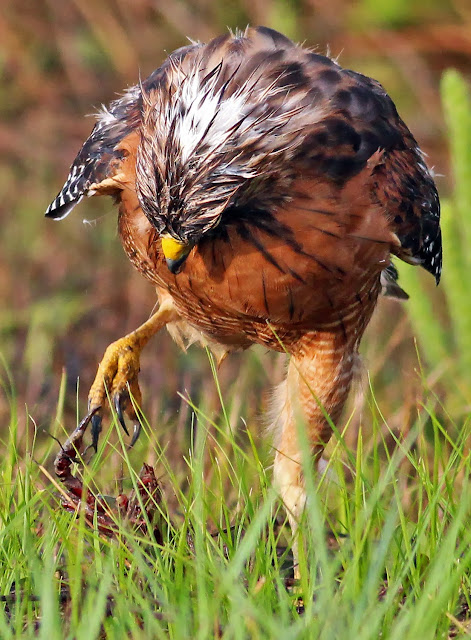 |
| Who has who. A Red Shouldered Hawk’s attempt at catching a crayfish has the bird being caught by large crustacean claws |
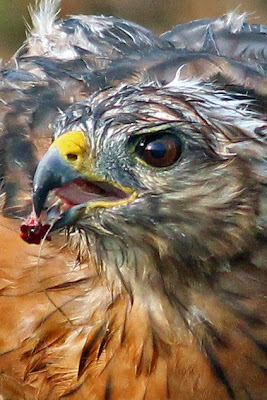 |
| Eating crayfish |
Red-shouldered Hawks eat mostly small varmits, lizards, snakes, and amphibians. They can be found hunting from perches below the Great Trinity Forest canopy or at the edge of a pond, sitting silently until they sight their prey below. Then they descend swiftly, gliding and snatching a vole or chipmunk off the forest floor. They also eat toads, snakes, and as seen here crayfish.
Crayfish, most likely sent into the grass after the heavy rains just minutes before were taken down by a dozen by the hawk that evening. One after the other, carefully stalked and eaten. A learned trait by the hawk no doubt. A rare treat to see such a thing.
